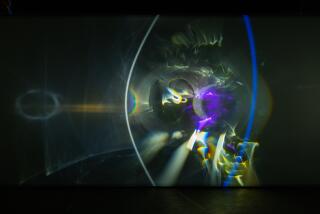Column: Why ‘unpacking’ is a perfect — and perfectly overused — metaphor for our cultural moment
Can we unpack “unpack”?
The verb remains a favored bit of jargon among journalists and academics, who use it to mean pretty much any effort to break a complicated idea, theory or assumption into its constituent parts for easier analysis. There’s so much unpacking going on at a typical symposium or conference these days that you begin to worry about tripping over all the empty luggage.
Blame Walter Benjamin. The German philosopher’s 1931 essay, “Unpacking My Library: A Talk About Book Collecting,” first popularized the U-word as a metaphor. For those of us who admire and continue to read Benjamin but wish “unpack” would pack up and go — who think overuse has left it nearly meaningless — this spring has not been a happy season. In architecture and museum circles the essay is on its way from trendy to ubiquitous.
The introductory exhibition at L.A.’s newest museum, the Marciano Art Foundation on Wilshire Boulevard, is called “Unpacking: The Marciano Collection.” The curator, Philipp Kaiser, writes in the catalog that deciding which artworks from the collection of the Guess Jeans founders Paul and Maurice Marciano to put on view was a task that “invariably called to mind Benjamin.”
On the other side of the country, the Museum of Modern Art will open a major exhibition Monday called “Frank Lloyd Wright at 150: Unpacking the Archive.” The show is meant not only to mark the anniversary of Wright’s 1867 birth but to celebrate the fact that the architect’s archive, long held at his Taliesin compounds in Wisconsin and Arizona, is now jointly owned by MoMA and Columbia University.
Among the questions that hover over the exhibition: What does it mean that a pair of Manhattan’s wealthiest and most august institutions have appointed themselves to safeguard the legacy of an eccentric architect whose relationship with cities in general and New York City in particular was iffy at best — and who made a point of removing himself to the desert, 2,500 miles away, for the long second half of his career?
That’s a lot to unpack.
Benjamin was 39 when he wrote “Unpacking My Library.” He and wife Dora had divorced two years before. The essay is superficially about the act of organizing his large book collection on the shelves of his apartment in Berlin. It’s really about the habits, foibles and vanities of collectors. And about poles: about the movement (some of which we can control and some of which we can’t) between order and disorder, excitement and boredom and youth and old age.
SIGN UP for the free Essential Arts & Culture newsletter »
It’s about the renewal we try to find in the things and people we gather around us, an effort that tends to accelerate the older we get. “I am not exaggerating when I say that to a true collector the acquisition of an old book is its rebirth,” Benjamin writes.
He admits, though, that there was a period when he was adamant about not reading the books he acquired. The militancy of non-reading among book collectors is a major theme.
There’s no such subtlety or self-deprecation in Kaiser’s essay. I doubt MoMA will portray its acquisition of the Wright archive in any but the noblest of terms.
At one point in the essay Benjamin uses a short Latin phrase, “Habent sua fata libelli.” It’s a fragment of a longer saying, “Pro captu lectoris habent sua fata libelli,” which basically means that the fate of a given book depends on the capacities, the intelligence, of those who happen to pick it up. Dull readers make dull books.
The same is true of metaphors. “Unpack” has become a victim of its most enthusiastic users. But killing this particular cliché may be tougher than it sounds. Eighty-six years after the Benjamin essay appeared, the term has gathered enough momentum to seem Rasputin-like.
Why? It clearly scratches some cultural itch. It has something to do with the way we increasingly think of intelligence as something to perform — in particular the way we use social media as a stage to display our knowledge of one subject or another.
Unpacking has become something we (and by “we” I mostly mean “men”) do in public. It’s analysis that proceeds step by step.
The Twitter thread is unpacking taken to its logical 21st century extreme. (Unlike writing an essay, which is more like packing than unpacking.) Each linked tweet is a book held up for notice, spine pointed toward one’s followers, on its way from box to bookcase.
This version of unpacking also brings instant attention of the kind Benjamin never experienced. (The Canadian writer Jeet Heer spun his threading prowess into a senior editor gig at the New Republic.) That makes me think the metaphor will be around for a while and that this column will do absolutely nothing to slow its spread.
In this sense Benjamin — and here is a comparison I guarantee you didn’t see coming — is like Donald Trump. The best way to analyze either man’s body of work is simply to quote his own words. There is an aphorism or one-liner (or in the president’s case a tweet) for every occasion.
Wrote Benjamin: “Nothing highlights the fascination of unpacking more clearly than the difficulty of stopping this activity.” You said it, Walter.
Building Type is Christopher Hawthorne’s weekly column on architecture and cities. Look for future installments every Thursday at latimes.com/arts.
Twitter: @HawthorneLAT
MORE BUILDING TYPE:
The architecture of moviegoing: Can the multiplex stay in the picture?
Marciano review: Former temple loses some personality in stylish redesign
Rich history, new anxieties inside MacArthur Park building where Berggruen Institute plans satellite
Design for Obama library and museum off to surprisingly somber start
More to Read
The biggest entertainment stories
Get our big stories about Hollywood, film, television, music, arts, culture and more right in your inbox as soon as they publish.
You may occasionally receive promotional content from the Los Angeles Times.











